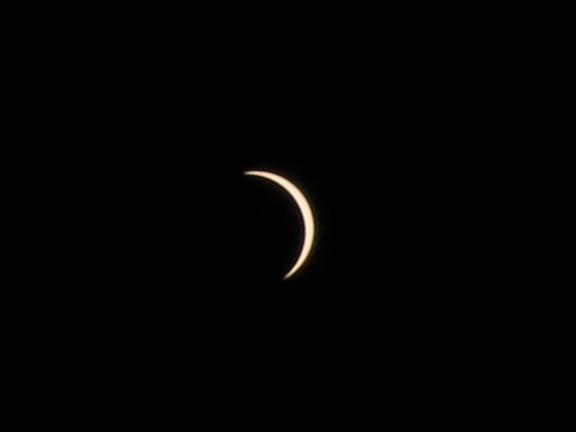A SUNY Oswego student-faculty team is heading to New Mexico this week to do research sponsored by NASA and the National Science Foundation during the annular solar eclipse, where the moon moves over the center of the sun to create a ring of fire appearance. (NASA image)
A team of six students and two faculty members are heading this week to New Mexico to conduct research during the weekend's annular eclipse as part of the Nationwide Eclipse Ballooning Project (NEBP).
The team traveling to Moriarty, New Mexico, includes students Shaheen Chowdhury, Vincent DiBattista, Aurora Fitzgerald, Sarah Gryskewicz, Kaija Hoyt and Erik Knudsen, as well as Katelyn Barber of the atmospheric and geological sciences faculty and Natalia Lewandowska, SUNY Oswego planetarium director and physics faculty member. Participants are part of the MET390 course and lab, a special topics course on solar eclipses and stratospheric ballooning.
NEBP is a NASA and NSF-sponsored program that will broaden the participation of STEM learners by immersing teams from a wide range of higher education institutions in an innovative NASA-mission-like adventure in data acquisition and analysis through scientific ballooning during the Oct. 14, 2023, annular solar eclipse, and the April 8, 2024, total solar eclipse. Student participants will work with atmospheric science experts throughout the project and publish results in peer-reviewed journals.
Participating students also plan to set up a livestream and will partner with the SUNY Oswego Instagram account to show their work and behind-the-scenes activities.
Other faculty involved in the research and educational components of the project include Shashi Kanbur of physics and Yonggang Wang of meteorology. MET390 has 19 students total, but logistics limit the number of students who can travel to New Mexico, where the eclipse path serves as a magnet for researchers and those with high levels of interest.
"We launched 10 practice weather balloons to prepare for the annular eclipse and these balloons ascended to altitudes greater than 28 km (17 miles) above the surface," Barber said. "The student safety team presented a lecture on hazards we would run into in New Mexico and our student outreach team will conduct their first event at Central Square High School at the end of this month."
Barber noted that the students stepped up to the demands of the project.
"Without the diligence, patience, and dedication these students showed in the first six weeks of the semester we would not have been prepared for the annular eclipse," Barber said.
Eclipse information
Viewing conditions in Central New York will not be as favorable for a full view of the Saturday, Oct. 14, annual event, where the moon moves in front of the sun’s center to create what looks like a ring of fire. The Rice Creek Field Station Observatory will host a short presentation and safe viewing opportunity, using solar glasses and portable telescopes outfitted for solar viewing from noon to 2:30 p.m. on Oct. 14. The eclipse will be visible at 12:02 p.m., reach its maximum at 1:14 p.m. and end at 2:27 p.m.
A cross-campus committee is already working on plans for the April 2024 total solar eclipse, where Central New York is a prime viewing area. Stay tuned to Oswego Today for details.




